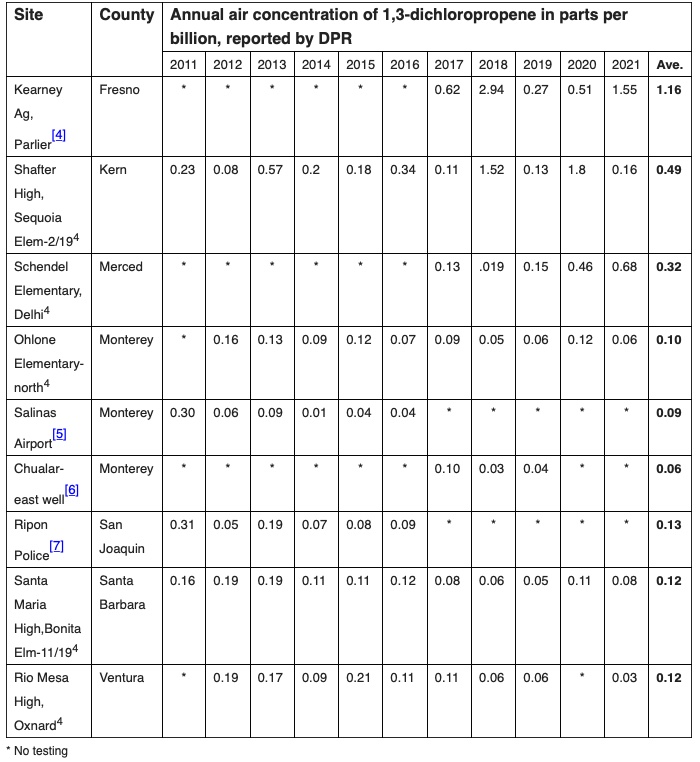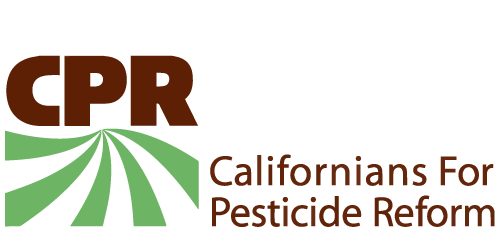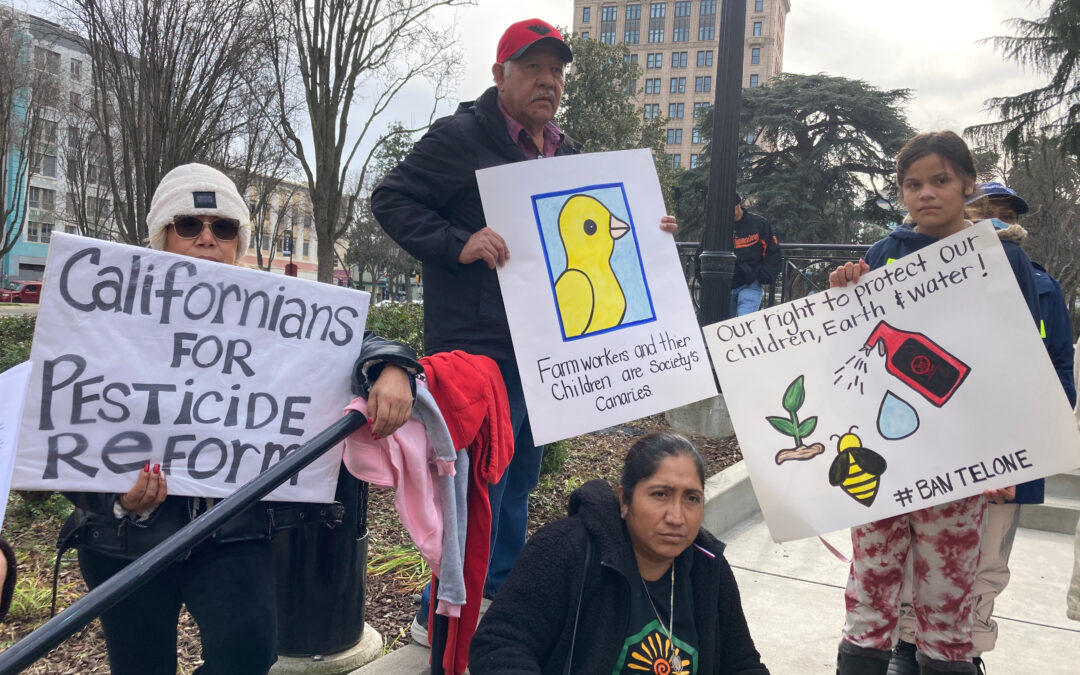March 17, 2023
For further information contact:
Jane Sellen, jane@pesticidereform.org
Angel Garcia, angel@pesticidereform.org
Draft regulation for fumigant 1,3-dichloropropene must protect farmworkers who labor near fields
Oakland, CA – The Alameda County Superior Court ruled last week that a proposed regulation fails to protect farmworkers who labor near fumigated fields from harmful levels of exposure to the cancer-causing pesticide 1,3-dichloropropene (1,3-D, or Telone). Judge Evelio Grillo gave the California Department of Pesticide Regulation (DPR) six months to propose a new regulation that protects farmworkers and other occupational bystanders. DPR was also ordered to continue the current 1,3-D use limit of 136,000 adjusted total pounds per 6×6 mile “township”, which the draft regulation would have eliminated, and to maintain a prohibition on December applications of this pesticide until the new regulation is finalized and adopted.
At more than 12 million pounds reported use per year, 1,3-D is the third most heavily applied pesticide in California agriculture, used as a pre-plant soil fumigant for berry crops along the Central Coast and for almonds, walnuts, sweet potatoes, and other crops in the San Joaquin Valley. 1,3-D is highly volatile, is classified as a Toxic Air Contaminant and a Prop. 65 carcinogen, and is banned in 34 countries. It is manufactured by Dow Chemical, an intervenor on the side of DPR in the case.
“We applaud the court’s ruling striking down DPR’s immoral and unjust draft regulation,” said Angel Garcia, co-director of the Lindsay-based Californians for Pesticide Reform. “The court has ruled that a draft rule that would have allowed farmworkers to work right next to the edge of treated fields while they are being fumigated was unlawful. We look forward to a new regulation that corrects the profound environmental injustice of failing to protect farmworkers from this highly hazardous and drift-prone chemical.”
Two agencies, two different 1,3-D cancer risk levels
State law[1] mandates that DPR must involve the Office of Environmental Health Hazard Assessment (OEHHA) as a partner in development of pesticide regulations that address risks to workers, including both fieldworkers and pesticide handlers. DPR and OEHHA are sister offices within CalEPA, but have reached strikingly different conclusions about the hazards of 1,3-D exposure. In June 2022, OEHHA adopted a lifetime cancer risk level for 1,3-D – known as a No Significant Risk Level or NSRL – of 0.04 parts per billion (ppb), which is 14 times lower than the level (0.56 ppb) that DPR used for its draft regulation.[2] In comments, Dow Chemical publicly supported DPR’s target level. By excluding workers from their draft regulation, DPR hoped to skirt the law and ignore the recommendations of OEHHA. A regulation based on OEHHA’s cancer risk level would be far more health protective.
“OEHHA scientists have already informed Californians what the unsafe level of exposure to cancer-causing 1,3-D is. But DPR completely ignored that, siding with their buddies at Dow Chemical by proposing to allow for 14 times more 1,3-D in the air in Latino farmworker communities like mine,” said Yanely Martinez, Greenfield City Council member and organizer of Safe Ag Safe Schools. “We’re glad the judge sent DPR back to the drawing board to listen to OEHHA, because DPR’s proposal was unscientific and racist, as well as illegal.”
Are communities safe from 1,3-D? Not according to OEHHA’s No Significant Risk Level (NSRL)
DPR’s pesticide air monitoring network in farmworker communities indicates that, at all nine stations that tested 1,3-D in the air for more than two years, average air concentrations were above OEHHA’s 0.04 parts per billion NSRL. Schools have been the sites for five of these air monitor testing stations.
While the air monitors were placed near fields, some of the readings came from applications miles away. A one-day January 2020 spike of 20.8 parts per billion at Sequoia Elementary in Shafter originated from a 1,3-D application 7.5 miles away, according to DPR.[3] 1,3-D can drift for miles at harmful levels.
TABLE. 1,3-dichloropropene air concentrations are above OEHHA’s 0.04 ppb NSRL for lifetime cancer risk at all 9 air monitor stations that tested for more than 2 years

Melissa Dennis, a second grade teacher at the 98% Latino Ohlone Elementary School where one of the pesticide air monitors sits, commented: “My students are worth 14 times less than others in California. That’s what DPR was telling us with its 1,3-D proposed regulation.”
Going forward, Bianca Lopez, co-founder of the Modesto-based Valley Improvement Projects said: “The court’s decision is a huge win for farmworkers, and puts the agricultural industry on notice that it can no longer go on poisoning workers with harmful chemicals. It’s no mystery why a department like DPR, which gets 80% of its funding from pesticide sales, would be so determined to preserve the use of a heavily used chemical like 1,3-D.”
Ms. Lopez added: “DPR has shown itself to be more interested in preserving use of this hazardous pesticide than in protecting human health. Now, they must listen to the scientists at OEHHA who have called for far greater protections from this deadly chemical.”
###################################################################
[1] Food and Agricultural Code sections 12980 and 12981
[2] 1,3-D NSRL = 3.7 micrograms (ug) per day. Breathing rate used by OEHHA = 20 cubic meters (m3) per day (from OEHHA regs 27 CCR § 25721 Level of Exposure to Chemicals Causing Cancer). https://govt.westlaw.com/calregs/Document/IBBC153FD512211EC828B000D3A7C4BC3?viewType=FullText&originationContext=documenttoc&transitionType=CategoryPageItem&contextData=(sc.Default) A person breathing air contaminated with 3.7/20 (=.185) ug/m3 of 1,3-D will be exposed to 3.7 ug/m3 or 0.04 ppb per day.
[3] https://www.pesticidereform.org/wp-content/uploads/2021/09/202109-CPR-Telone-Shafter-ENGv1.pdf; also DPR’s Minh Pham “A summary of notable detections at Shafter AMN site in 2020” not available on DPR’s website.
[4] DPR presentation to Pesticide Registration and Evaluation Committee, “2021 1,3-D Ambient Air Monitoring Results,” slide 29.
[5] “Air Monitoring Network Report: A Comprehensive Evaluation of Results (2011 – 2016),” DPR, June 2018, p. 38.
[6]DPR presentation to the July 15, 2022 Pesticide Registration Evaluation Committee, “2019 1,3 D Ambient Air Monitoring Results,” slide 29.
[7] “Air Monitoring Network Report: A Comprehensive Evaluation of Results (2011 – 2016),” DPR, June 2018, p. 42.

